So, have you been following the path of the waning Moon through the dawn sky this week? The slender Moon visits some interesting environs over the coming weekend, and heralds the start of Ramadan across the Islamic world next week.
First up, the planet Mercury rises an hour before the Sun in the dawn this week. Mercury reaches greatest elongation west of the Sun on Sunday, June 5th at 9:00 Universal Time (UT).
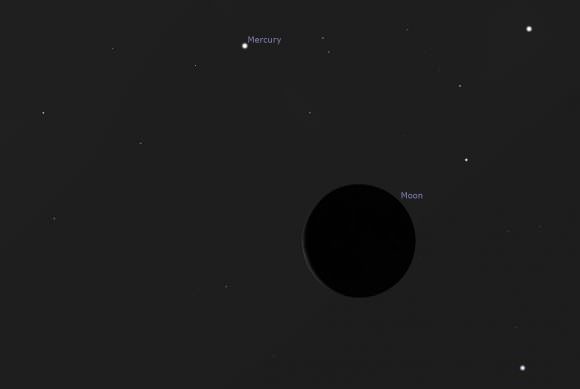
The slender waning crescent Moon passes less than one degree from +0.8 magnitude Mercury (both 24 degrees from the Sun) on the morning of Friday, June 3rd at 10:00 UT. While this is a close shave worldwide, the Moon will actually occult (pass in front of) Mercury for a very few observers fortunate enough to be based on the Falkland Islands in the southern Atlantic.
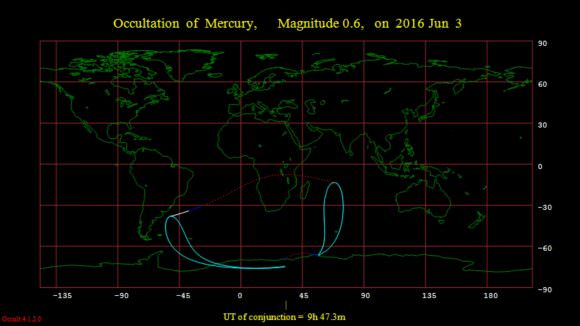
The Moon is 5.2% illuminated and 41 hours from New during the occultation. Meanwhile, Mercury shines at magnitude +0.8 and displays an 8.6” 33.5% illuminated disk during the event. Also, watch for ashen light or Earthshine faintly lighting up the nighttime side of the Moon. You’re seeing sunlight, bounced off of the land, sea and (mostly) cloud tops of the fat waxing gibbous Earth back on to the lunar surface, one light-second away. The Big Bear Solar Observatory has a project known as Project Earthshine which seeks to measure and understand the changes in albedo (known as global dimming) and its effects on climate change.
The Moon occults Mercury three times in 2016. Occultations of the innermost planet are especially elusive, as they nearly always occur close to the Sun under a daytime sky. This week’s occultation occurs less than 48 hours from greatest elongation; the last time one was closer time-wise was March 5th, 2008, and this won’t be topped until February 18th, 2026, with an occultation of Mercury by the Moon just 18 hours prior to greatest elongation. And speaking of which, can you spy +0.8 magnitude Mercury near the crescent Moon on Friday… during the daytime? Use binocs, note where Mercury was in relation to the Moon before sunrise, but be sure to physically block that blinding Sun behind a building or hill!
Mercury reaches greatest elongation six times in 2016: three in the dusk (western), and three in the dawn (eastern).
The Moon also passes less than five degrees from the planet Venus on June 5th at 2:00 UT, though both are only 2 degrees from the Sun. Fun fact: the bulk of the Sun actually occults Venus for 47 hours as seen from the Earth from June 6th through June 8th.
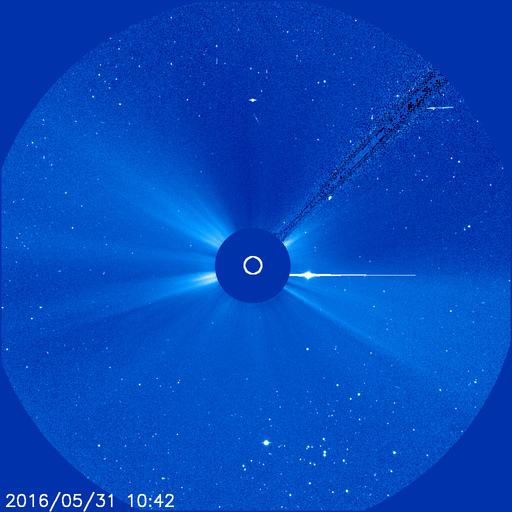
You can observe the passage of Venus through the 15 degree wide field of view of SOHO’s LASCO C3 camera over the next few weeks until July 5th.
Venus reaches superior conjunction on the far side of the Sun 1.74 astronomical units (AU) from the Earth at 21:00 UT on Monday, June 6th.
New Moon occurs at 4:00 UT on Sunday, June 5th, marking the start of lunation 1156.
The Moon and Ramadan
The first sighting of the slim crescent Moon also marks the start of the month of Ramadan (Ramazan in Turkey) on the Islamic calendar. Unlike the western Gregorian calendar, which is strictly solar-based, and the Jewish calendar, which seeks to reconcile lunar and solar cycles, the Islamic is solely based on the 29.5 synodic period of the Moon. This means that it moves forward on average 11 days per Gregorian year. The hallmark of Ramadan is fasting from dawn to dusk, and Ramadan 2016 is an especially harsh one, falling across the northern hemisphere summer solstice (and the longest day of the year) on June 20th. The earliest sunrise occurs on June 14th, and latest sunset on June 27th for latitude 40 degrees north. Finally, the Earth reaches aphelion or its farthest point from the Sun on July 4th at 1.01675 AU or 157.5 million kilometers distant.
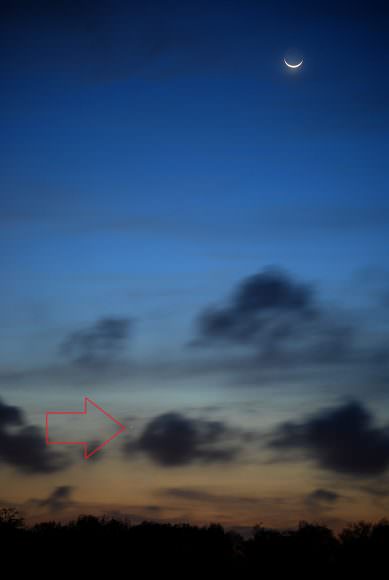
In 2016, the Moon will first likely be spotted from the west coast of South America on Sunday night June 5th, though many locales worldwide may not see the Moon until June 6th. There can be some disparity as to just when Ramadan starts based on the first sighting of the crescent Moon. The Islamic calendar is also unique in that it still relies on direct observation of the waxing crescent Moon. Other calendars often use an estimated approximation in a bid to keep their timekeeping in sync with the heavens. The computus estimation (not a supervillain, though it certainly sounds like one!) used by the Catholic Church to predict the future date of Easter, for example, fixes the vernal equinox on March 21st, though it actually falls on March 20th until 2048, when it actually slips to March 19th.
Ramadan has been observed on occasion in space by Muslim astronauts, and NASA even has guidelines stipulating that observant astros will follow the same protocols as their departure point from the Earth (in the foreseeable future, that’s the Baikonur Cosmodrome in Kazakhstan.
Can you see the open cluster M35, just six degrees north (right) of the thin crescent Moon on the evening of Monday, June 6th?
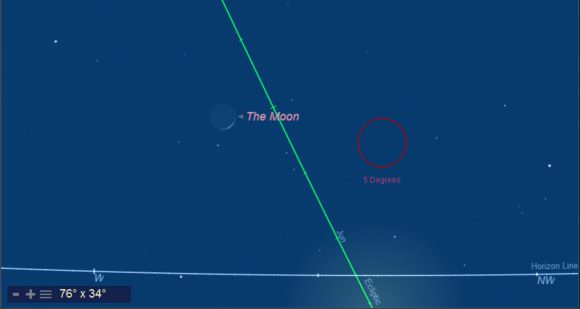
We think its great to see direct astronomical observation still having a hand in everyday human affairs. This also holds a special significance to us, as we’re currently traveling in Morocco.
Don’t miss the meeting of Mercury and the Moon on Friday morning, and the return of the Moon to the dusk skies next week.

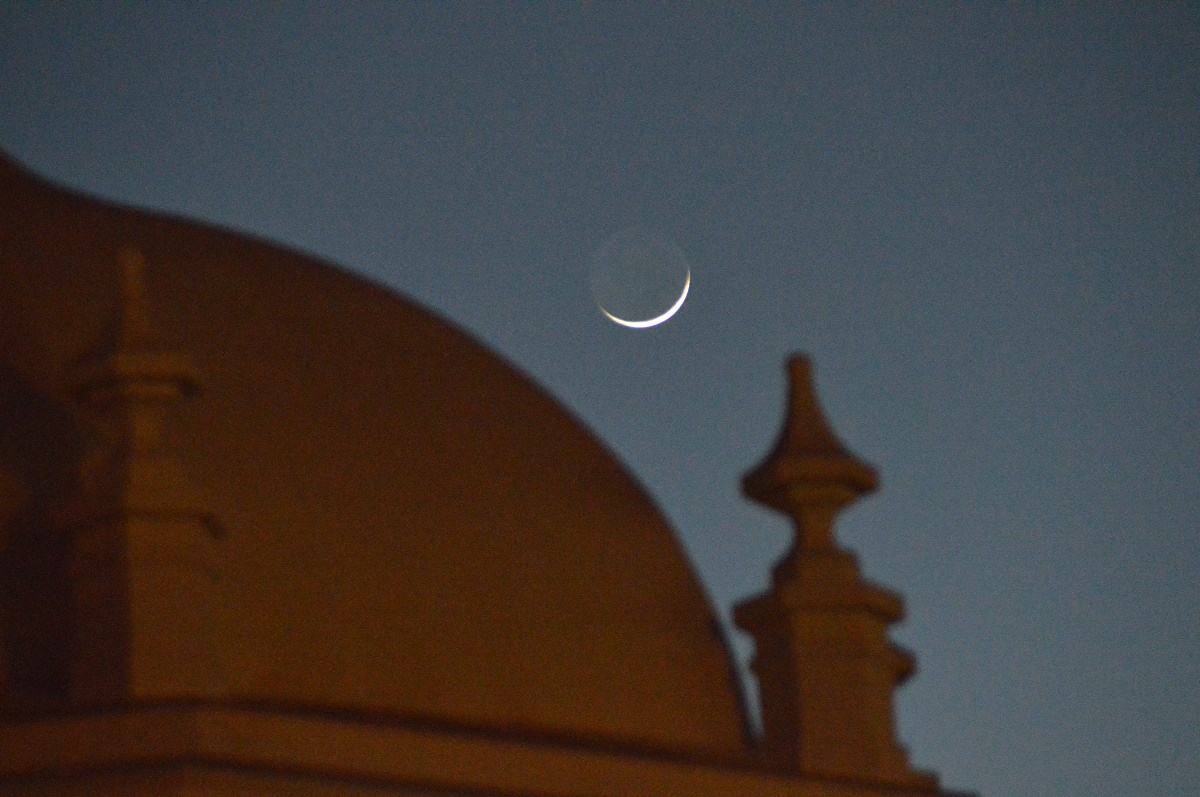
very good woman
I get paid 96 dollar every hour for work at home on my PC. I never thought I’d be able to do it but my lovely girls friiend is earning 19k /monthly by doing this job and she showed me what he do. See here what i do..—/85k
~~~ http://www.NetPay50.Tk
I noticed that Mercury will be twice as bright at magnitude +0.7 on Friday. Could you double check? Thanks!
Hmmm… I pulled the +1.4 figure from Stellarium, checking Heavens-Above and Sky and Tel, +0.8 does indeed seem to be the case. Good catch, 2 out of 3,,,